Enhancing Hydraulic Lime Mortar with Metakaolin: A Study on Improving Restoration Materials for Historic Buildings
Abstract
:1. Introduction
2. Sampling and Analysis of Raw Materials for Historic Buildings
3. Materials and the Mixing Proportion
3.1. Raw Materials
3.1.1. White Cement
3.1.2. Metakaolin
3.1.3. Hydrated Lime
3.1.4. Heavy Calcium Carbonate
3.1.5. Sand
3.2. Design of Mixing Proportion
3.3. Sample Preparation and Curing Process
4. Effect of MK Content on the Physical Properties of HLM
4.1. Fluidity
4.2. Water Consumption for Standard Consistency and Setting Time
4.3. Moisture Content and Water Absorption
4.4. Mass Change
4.5. Drying Shrinkage
4.6. Water Vapor Transmission Properties
5. Effect of MK Content on Mechanical Properties of HLM
5.1. Flexural and Compressive Strengths
5.2. Bonding Strength
5.3. Elastic Properties and Stress–Strain Curves
6. Mechanistic Analysis
6.1. XRD Analysis
6.2. SEM Analysis
7. Conclusions
- (1)
- As the amount of MK increases in HLM, its fluidity decreases, and too much MK can adversely affect the mortar’s workability.
- (2)
- The addition of MK increases the water consumption for standard consistency in HLM due to its large specific surface area, and it also shortens the setting time of the mortar.
- (3)
- MK consumption in HLM promotes secondary hydration, enhancing compressive and flexural strength. The bonding strength of HLM increased with the addition of MK, reaching optimal performance at around 9% MK content.
- (4)
- Adding MK can enhance the density of HLM, while slightly reducing its moisture content and water absorption. The water vapor transmission properties decreased, indicating reduced porosity.
- (5)
- The elastic properties and stress–strain curves indicated that the elastic modulus of the mortar increased significantly with the addition of MK, enhancing the material’s rigidity and crack resistance.
- (6)
- Incorporating 9.0% MK and 25.0% heavy calcium carbonate into HLM forms the optimal blend for restoration materials. This specific combination is characterized by its moderate mechanical strength, enhanced early strength, commendable permeability, minimal risk of cracking, and ease of application, making it well suited for the rehabilitation of historic structures.
Author Contributions
Funding
Institutional Review Board Statement
Informed Consent Statement
Data Availability Statement
Conflicts of Interest
References
- Ornelas, C.; Sousa, F.; Guedes, J.M.; Breda-Vázquez, I. Monitoring and Assessment Heritage Tool: Quantify and classify urban heritage buildings. Cities 2023, 137, 104274. [Google Scholar] [CrossRef]
- Munarim, U.; Ghisi, E. Environmental feasibility of heritage buildings rehabilitation. Renew. Sustain. Energy Rev. 2016, 58, 235–249. [Google Scholar] [CrossRef]
- Shan, M.; Chen, Y.-F.; Zhai, Z.; Du, J. Investigating the critical issues in the conservation of heritage building: The case of China. J. Build. Eng. 2022, 51, 104319. [Google Scholar] [CrossRef]
- Guzmán, P.C.; Roders, A.R.P.; Colenbrander, B.J.F. Measuring links between cultural heritage management and sustainable urban development: An overview of global monitoring tools. Cities 2017, 60, 192–201. [Google Scholar] [CrossRef]
- Aggelakopoulou, E.; Bakolas, A.; Moropoulou, A. Properties of lime–metakolin mortars for the restoration of historic masonries. Appl. Clay Sci. 2011, 53, 15–19. [Google Scholar] [CrossRef]
- Kang, S.-H.; Lee, S.-O.; Hong, S.-G.; Kwon, Y.-H. Historical and Scientific Investigations into the Use of Hydraulic Lime in Korea and Preventive Conservation of Historic Masonry Structures. Sustainability 2019, 11, 5169. [Google Scholar] [CrossRef]
- Elert, K.; Rodriguez-Navarro, C.; Sebastián, E.; Hansen, E.; Cazalla, O. Lime Mortars for the Conservation of Historic Buildings Author(s). Stud. Conserv. 2002, 47, 62. [Google Scholar] [CrossRef]
- Vavričuk, A.; Bokan-Bosiljkov, V.; Kramar, S. The influence of metakaolin on the properties of natural hydraulic lime-based grouts for historic masonry repair. Constr. Build. Mater. 2018, 172, 706–716. [Google Scholar] [CrossRef]
- Silva, B.A.; Pinto, A.P.F.; Gomes, A. Influence of natural hydraulic lime content on the properties of aerial lime-based mortars. Constr. Build. Mater. 2014, 72, 208–218. [Google Scholar] [CrossRef]
- Grilo, J.; Silva, A.S.; Faria, P.; Gameiro, A.; Veiga, R.; Velosa, A. Mechanical and mineralogical properties of natural hydraulic lime-metakaolin mortars in different curing conditions. Constr. Build. Mater. 2014, 51, 287–294. [Google Scholar] [CrossRef]
- Garijo Alonso, L.; Zhang, X.; Ruiz, G.; Ortega, J.J. Age effect on the mechanical properties of natural hydraulic and aerial lime mortars. Constr. Build. Mater. 2019, 236, 117573. [Google Scholar] [CrossRef]
- Shaoyun, Z.; Manli, S.; Qinglin, G.; Linyi, Z.; Zhipeng, L. Study on the Mechanical Properties and Durability of Hydraulic Lime Mortars Based on Limestone and Potassium Feldspar. Appl. Sci. 2023, 13, 2412. [Google Scholar] [CrossRef]
- Luo, K.; Li, J.; Lu, Z.; Jiang, J.; Niu, Y. Effect of nano-SiO2 on early hydration of natural hydraulic lime. Constr. Build. Mater. 2019, 216, 119–127. [Google Scholar] [CrossRef]
- Moon, K.Y.; Cho, J.S.; Choi, M.K.; Cho, K.H.; Ahn, J.W.; Hong, C.W.; Ur, S.C. Effect of blast furnace slag on the hydration properties in natural hydraulic lime. J. Ceram. Process. Res. 2016, 17, 122–128. [Google Scholar]
- Bumanis, G.; Vitola, L.; Stipniece, L.; Locs, J.; Korjakins, A.; Bajare, D. Evaluation of Industrial by-products as pozzolans: A road map for use in concrete production. Case Stud. Constr. Mater. 2020, 13, e00424. [Google Scholar] [CrossRef]
- Fapohunda, C.; Akinbile, B.; Shittu, A. Structure and properties of mortar and concrete with rice husk ash as partial replacement of ordinary Portland cement—A review. Int. J. Sustain. Built Environ. 2017, 6, 675–692. [Google Scholar] [CrossRef]
- Tafraoui, A.; Escadeillas, G.; Vidal, T. Durability of the Ultra High Performances Concrete containing metakaolin. Constr. Build. Mater. 2016, 112, 980–987. [Google Scholar] [CrossRef]
- Andrejkovicová, S.; Velosa, A.L.; Ferraz, E.; Rocha, F. Influence of clay minerals addition on mechanical properties of air lime-metakaolin mortars. Constr. Build. Mater. 2014, 65, 132–139. [Google Scholar] [CrossRef]
- Navrátilová, E.; Rovnaníková, P. Pozzolanic properties of brick powders and their effect on the properties of modified lime mortars. Constr. Build. Mater. 2016, 120, 530–539. [Google Scholar] [CrossRef]
- Siddiqua, A.; Hahladakis, J.N.; Al-Attiya, W. An overview of the environmental pollution and health effects associated with waste landfilling and open dumping. Env. Sci. Pollut. Res. Int. 2022, 29, 58514–58536. [Google Scholar] [CrossRef]
- Albidah, A.; Alghannam, M.; Abbas, H.; Almusallam, T.; Al-Salloum, Y. Characteristics of metakaolin-based geopolymer concrete for different mix design parameters. J. Mater. Res. Technol. 2021, 10, 84–98. [Google Scholar] [CrossRef]
- Zhang, D.J.; Zhao, J.H.; Wang, D.M.; Wang, Y.R.; Ma, X.D. Influence of pozzolanic materials on the properties of natural hydraulic lime based mortars. Constr. Build. Mater. 2020, 244, 118360. [Google Scholar] [CrossRef]
- Brooks, J.J.; Megat Johari, M.A. Effect of metakaolin on creep and shrinkage of concrete. Cem. Concr. Compos. 2001, 23, 495–502. [Google Scholar] [CrossRef]
- Al-Hashem, M.; Amin, M.; Ajwad, A.; Afzal, M.; Khan, K.; Faraz, M.; Qadir, M.; Khan, H. Mechanical and Durability Evaluation of Metakaolin as Cement Replacement Material in Concrete. Materials 2022, 15, 7868. [Google Scholar] [CrossRef] [PubMed]
- Silva, B.A.; Pinto, A.P.F.; Gomes, A. Natural hydraulic lime versus cement for blended lime mortars for restoration works. J. Constr. Build. Mater. 2015, 94, 346–360. [Google Scholar] [CrossRef]
- GB/T 2419-2005; Test Method for Fluidity of Cement Mortar. The Standardization Administration of the People’s Republic of China: Beijing, China, 2005.
- Alvarez, J.; Veiga, M.; Martínez-Ramírez, S.; Secco, M.; Faria, P.; Maravelaki-Kalaitzaki, P.; Ramesh, M.; Papayianni, I.; Valek, J. RILEM TC 277-LHS report: A review on the mechanisms of setting and hardening of lime-based binding systems. Mater. Struct. 2021, 54, 63. [Google Scholar] [CrossRef]
- Mohammadifar, L.; Miraki, H.; Rahmani, A.; Jahandari, S.S.; Mehdizadeh Miyandehi, B.; Rasekh, H.; Samadi, P.; Samali, B. Properties of Lime-Cement Concrete Containing Various Amounts of Waste Tire Powder under Different Ground Moisture Conditions. Polymers 2022, 14, 482. [Google Scholar] [CrossRef] [PubMed]
- Mehdipour, I.; Razzaghi, M.S.; Amini, K.; Shekarchi, M. Effect of mineral admixtures on fluidity and stability of self-consolidating mortar subjected to prolonged mixing time. Constr. Build. Mater. 2013, 40, 1029–1037. [Google Scholar] [CrossRef]
- GB/T 1346-2011; Test Methods for Water Requirement of Normal Consistency, Setting Time Andsoundness of the Portland cement. The Standardization Administration of the People’s Republic of China: Beijing, China, 2011.
- Andrejkovičová, S.; Maljaee, H.; Rocha, D.; Rocha, F.; Soares, M.; Velosa, A. Mortars for Conservation of Late 19th and Early 20th Century Buildings—Combination of Natural Cements with Air Lime. Materials 2022, 15, 3704. [Google Scholar] [CrossRef]
- El-Diadamony, H.; Amer, A.A.; Sokkary, T.M.; El-Hoseny, S. Hydration and characteristics of metakaolin pozzolanic cement pastes. HBRC J. 2019, 14, 150–158. [Google Scholar] [CrossRef]
- Zhao, Y.; Zhang, Y. A Review on Hydration Process and Setting Time of Limestone Calcined Clay Cement (LC3). Solids 2023, 4, 24–38. [Google Scholar] [CrossRef]
- JGJ/T 70-2009; Standard for Test Methods of Basic Properties of Building Mortar. Ministry of Housing and Urban-Rural Development: Beijing, China, 2009.
- Chi, M.; Huang, R. Effect of montmorillonite as additive on the properties of cement-based composites. Sci. Eng. Compos. Mater. 2012, 19. [Google Scholar] [CrossRef]
- Ince, C.; Carter, M.A.; Wilson, M.A. The water retaining characteristics of lime mortar. Mater. Struct. 2015, 48, 1177–1185. [Google Scholar] [CrossRef]
- Mahfouz, T.; Khedr, S.; Abdel-Mooty, M. Evaluation of lime mortars for the repair of historic buildings. In Structural Studies, Repairs and Maintenance of Heritage Architecture XI; WIT Press: Cambridge, MA, USA, 2009; pp. 209–220. [Google Scholar]
- Pan, Z.; Sanjayan, J.G.; Rangan, B.V. An investigation of the mechanisms for strength gain or loss of geopolymer mortar after exposure to elevated temperature. J. Mater. Sci. 2009, 44, 1873–1880. [Google Scholar] [CrossRef]
- Hassannezhad, K.; Akyol, Y.; Dursun, M.C.; Ow-Yang, C.W.; Gulgun, M.A. Effect of Metakaolin and Lime on Strength Development of Blended Cement Paste. Constr. Mater. 2022, 2, 297–313. [Google Scholar] [CrossRef]
- Kozlovcev, P.; Valek, J. The micro-structural character of limestone and its influence on the formation of phases in calcined products: Natural hydraulic limes and cements. Mater. Struct. 2021, 54, 217. [Google Scholar] [CrossRef]
- Frías, M.; Cabrera, J. Influence of MK on the Reaction Kinetics in MK/lime and MK-Blended Cement Systems at 20 °C. Cem. Concr. Res. 2001, 31, 519–527. [Google Scholar] [CrossRef]
- Schuab, M.; Santos, W.; Ribeiro Borges, P. On the development of MK/BFS alkali-activated materials as repair mortars: Performance under free and restrained shrinkage tests. Constr. Build. Mater. 2021, 275, 1. [Google Scholar] [CrossRef]
- GB/T 17146-2015; Test Methods for Water Vapour Transmission Properties of Building Materials and Products. The Standardization Administration of the People’s Republic of China: Beijing, China, 2015.
- GB/T 17671-2021; Test Method for Strength of Cement Mortar (ISO Method). The Standardization Administration of the People’s Republic of China: Beijing, China, 2021.
- Du, H.; Pang, S. High-performance concrete incorporating calcined kaolin clay and limestone as cement substitute. Constr. Build. Mater. 2020, 264, 120152. [Google Scholar] [CrossRef]
- Afzal, Q.; Abbas, S.; Abbass, W.; Ahmed, A.; Azam, R.; Riaz, M.R. Characterization of sustainable interlocking burnt clay brick wall panels: An alternative to conventional bricks. Constr. Build. Mater. 2020, 231, 117190. [Google Scholar] [CrossRef]
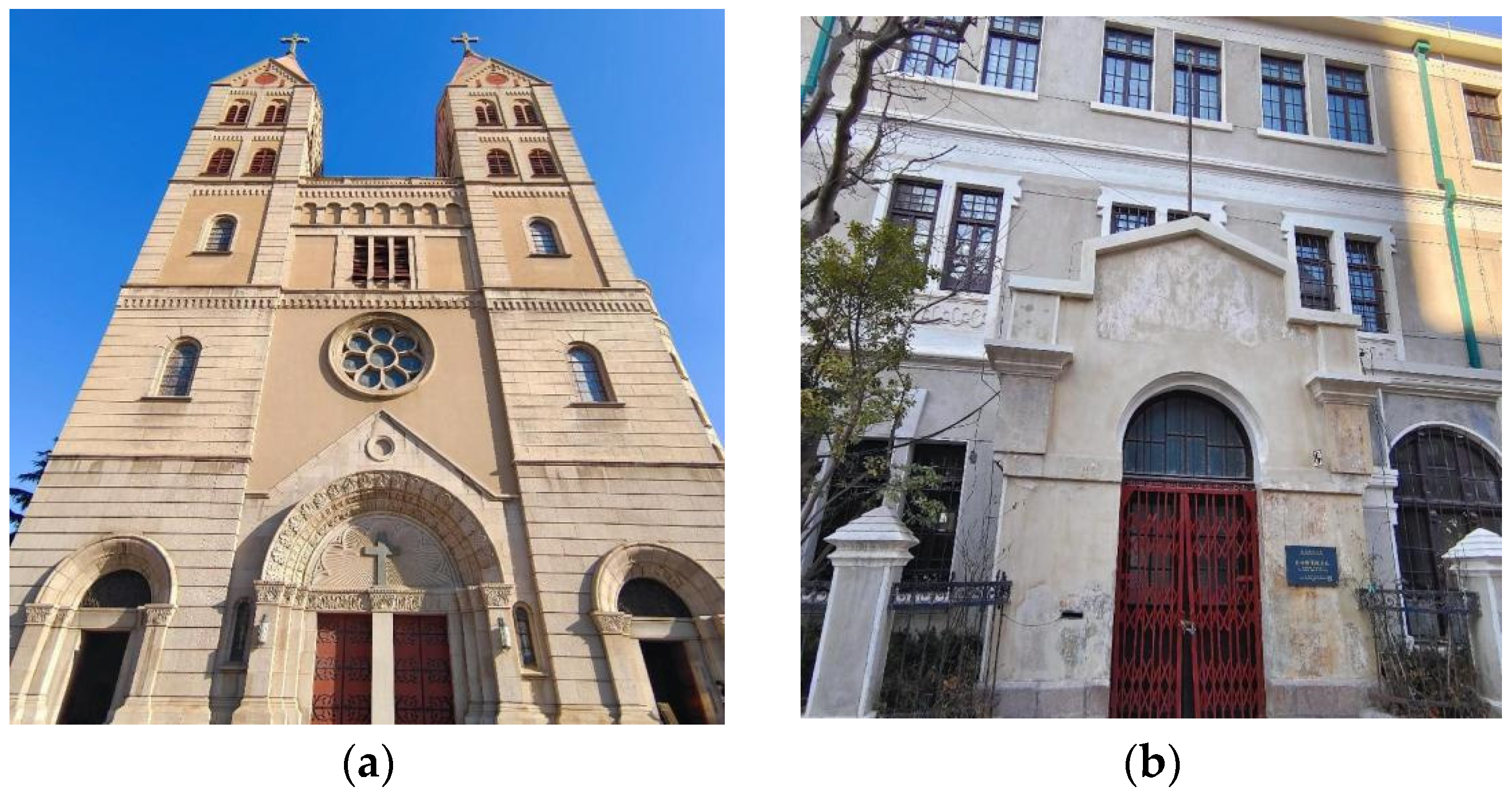
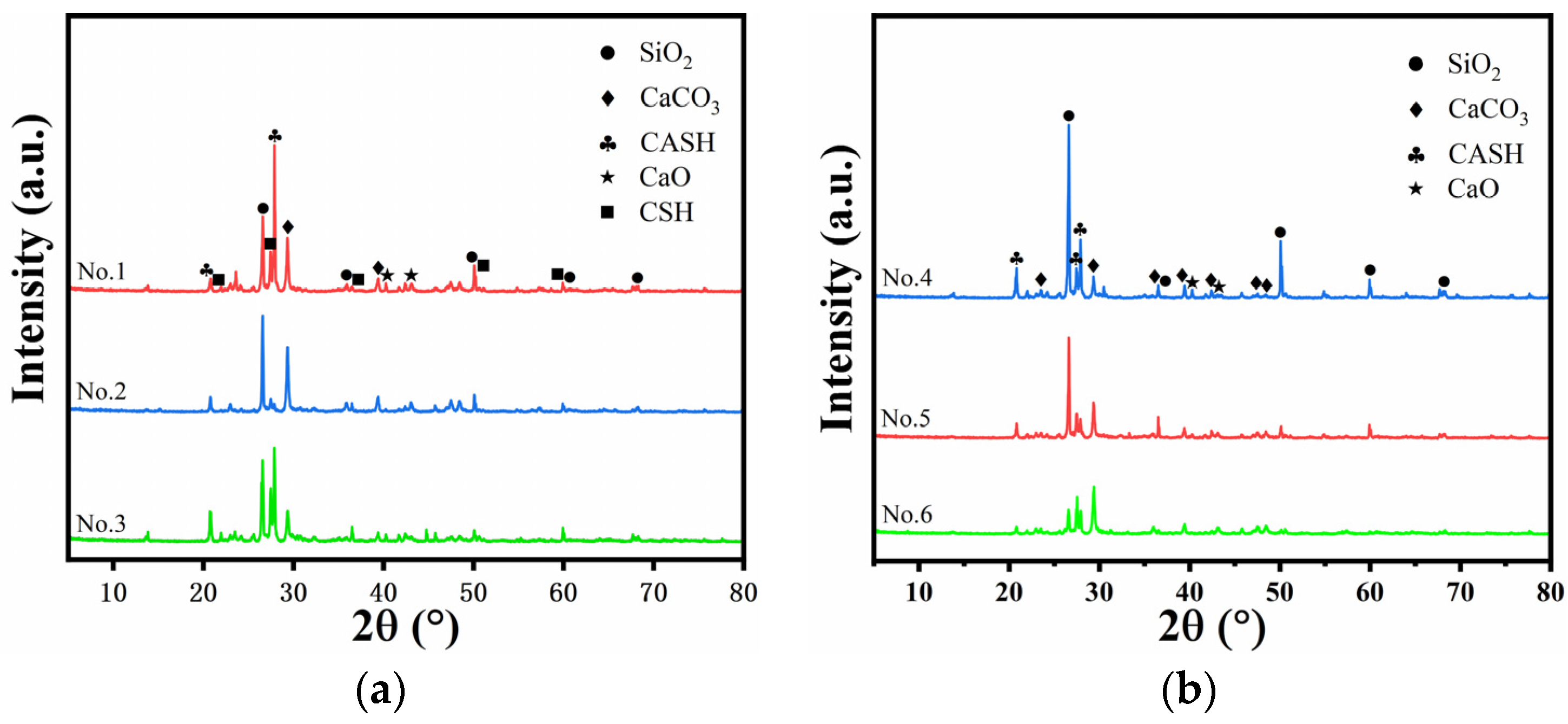

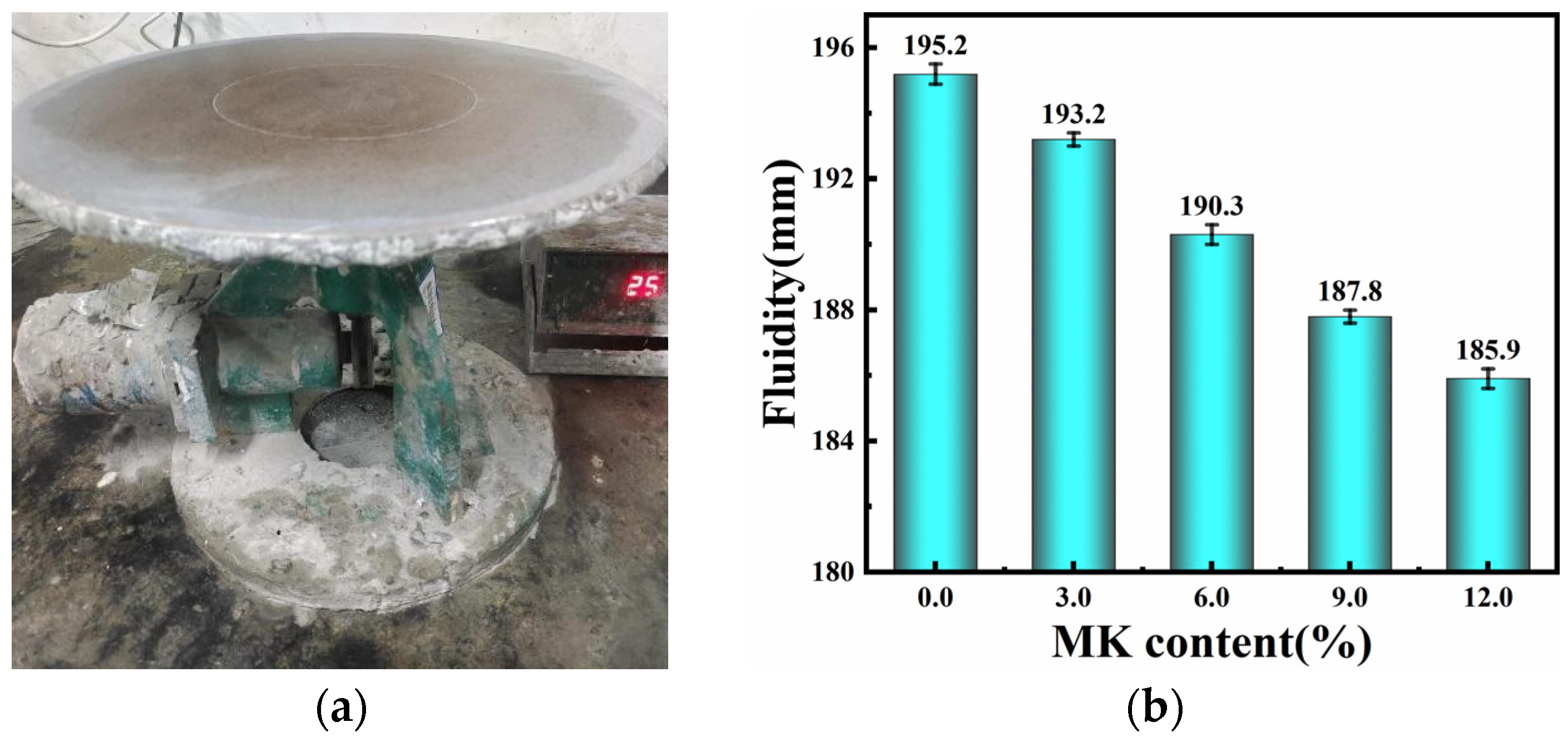
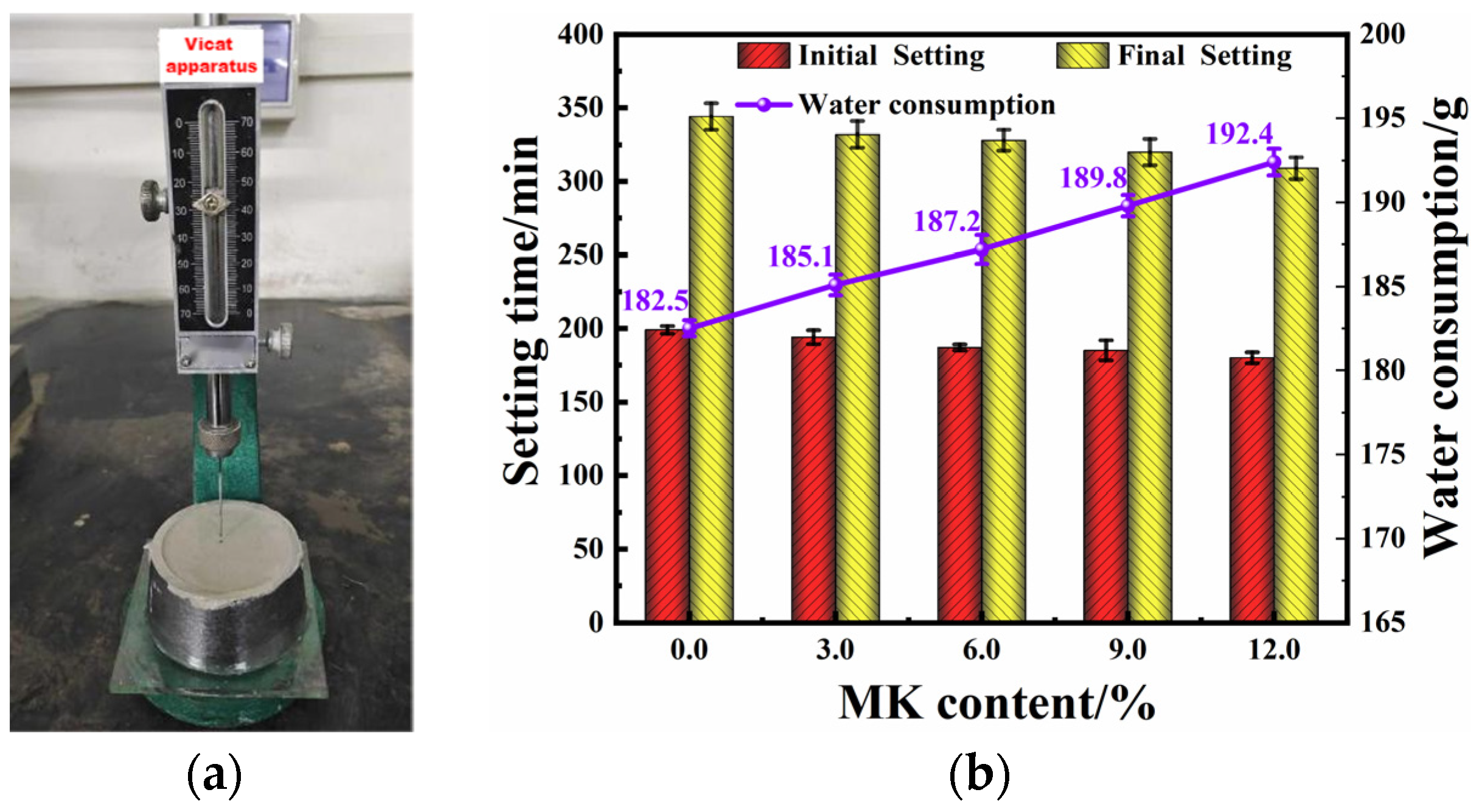

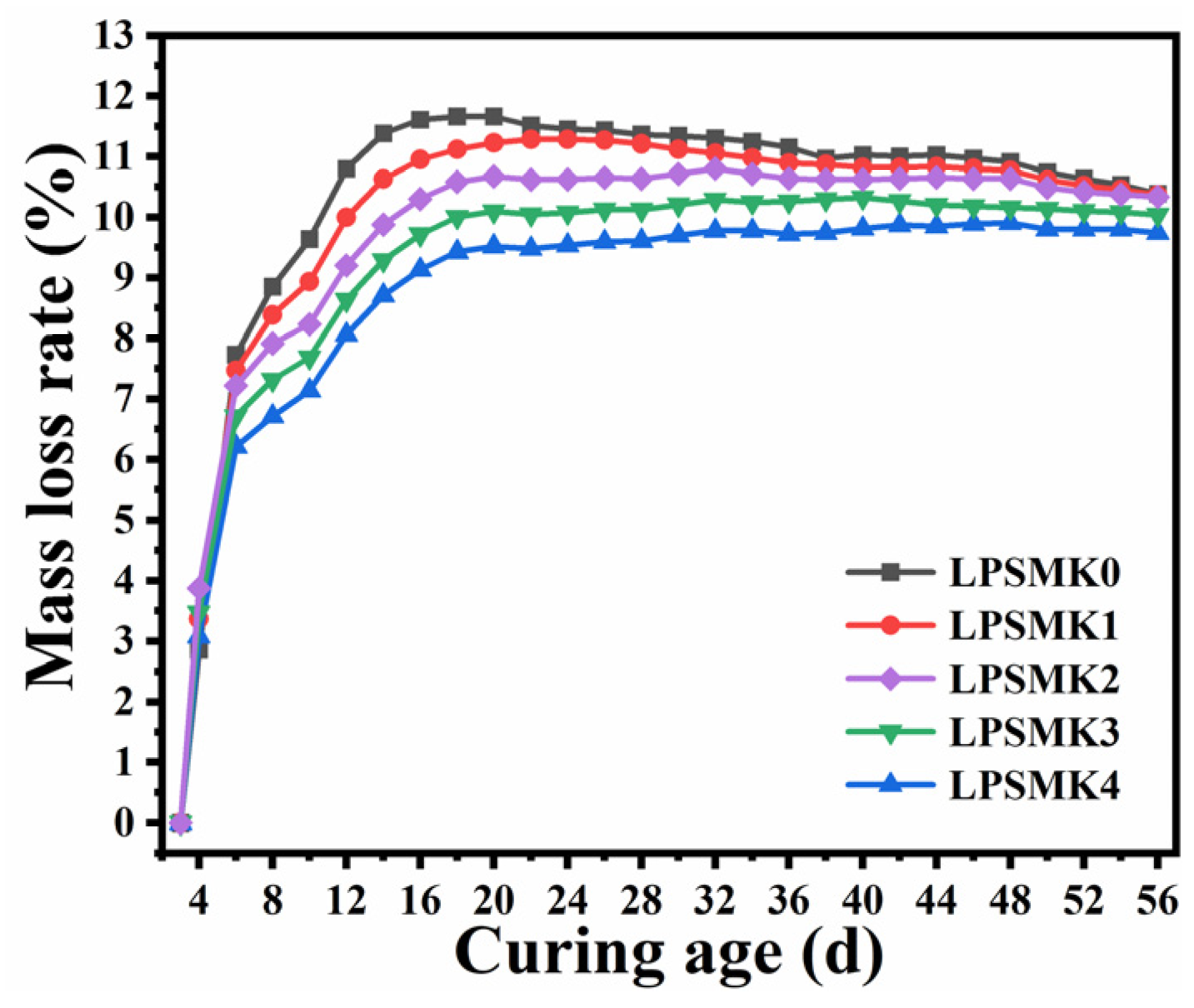
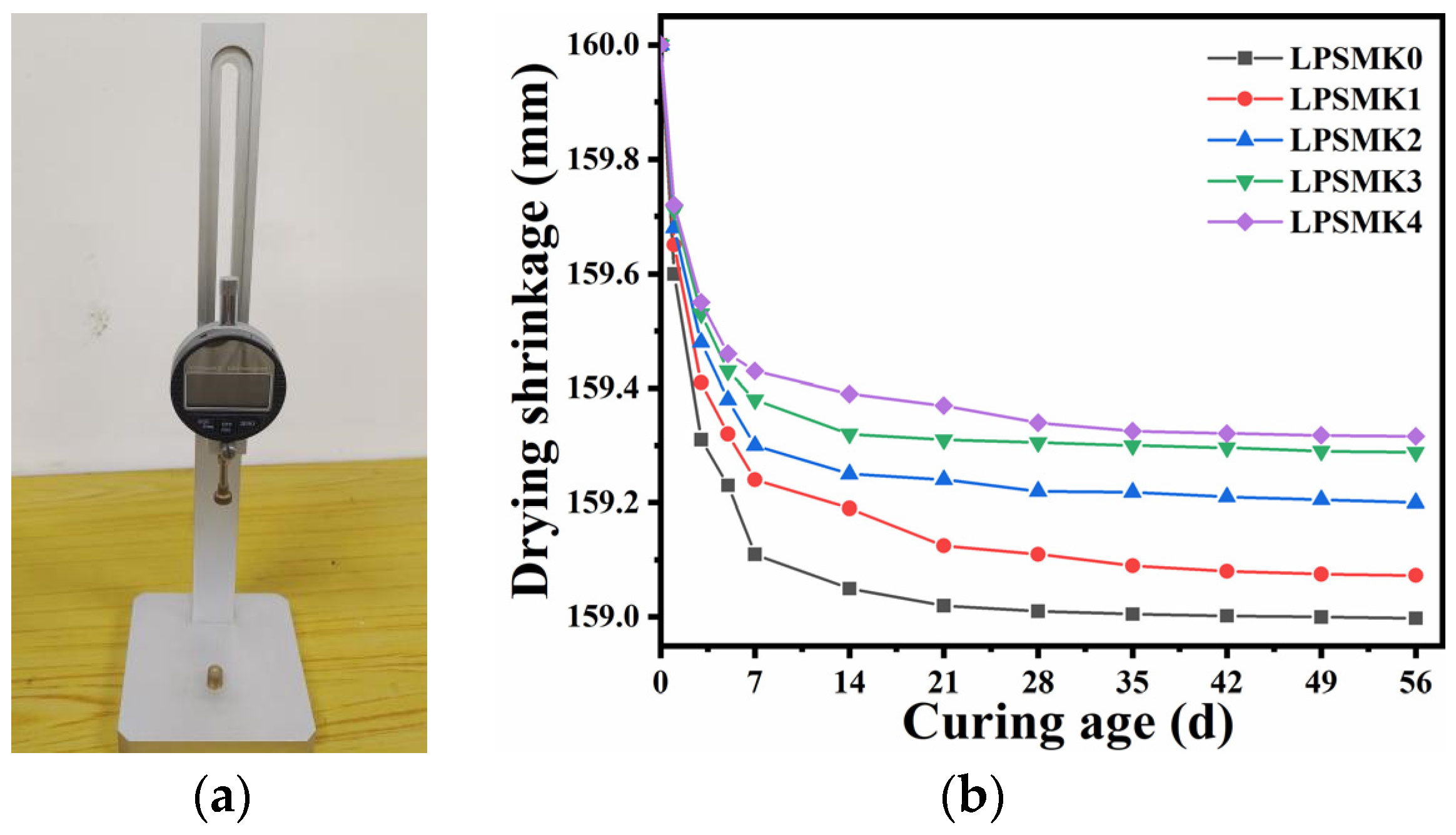
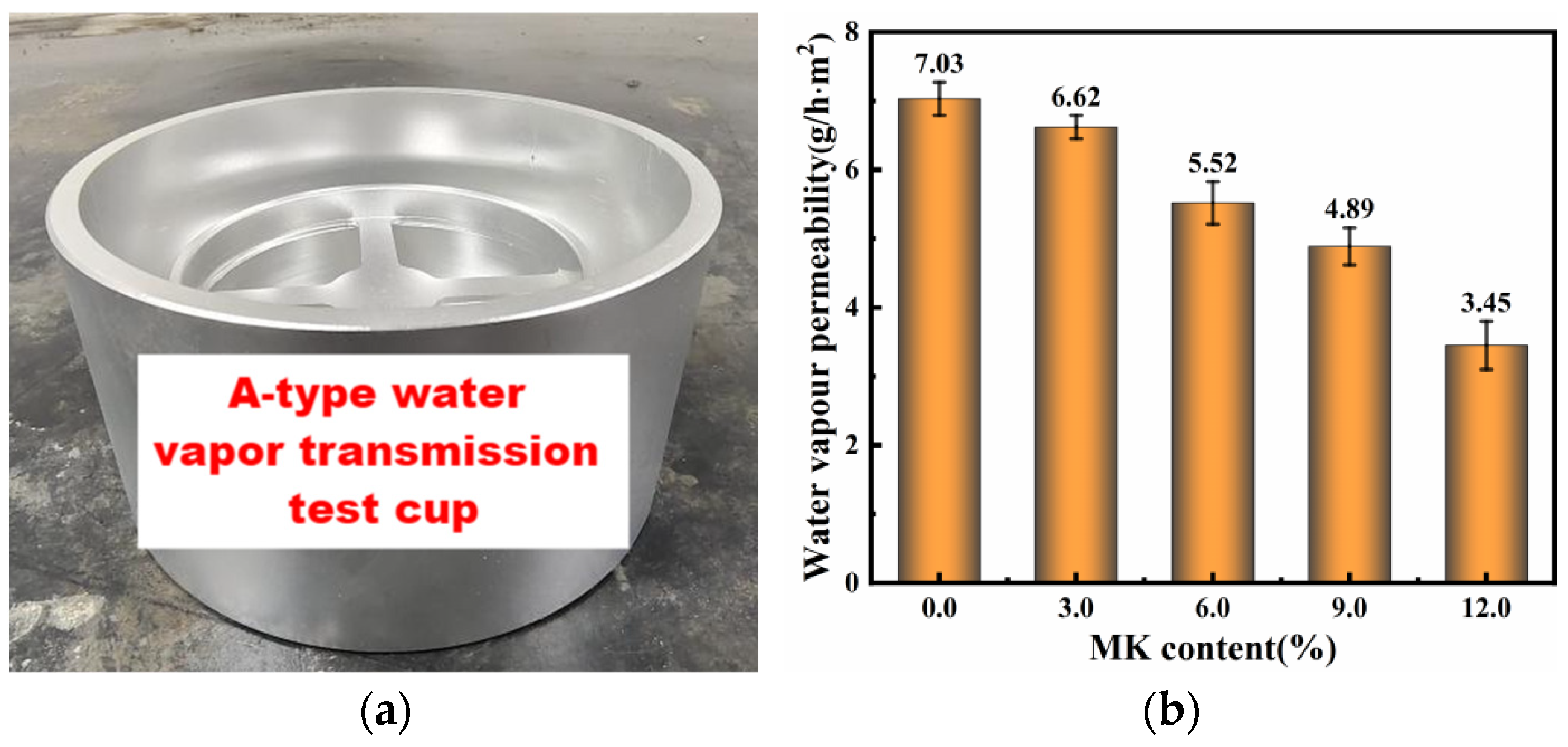


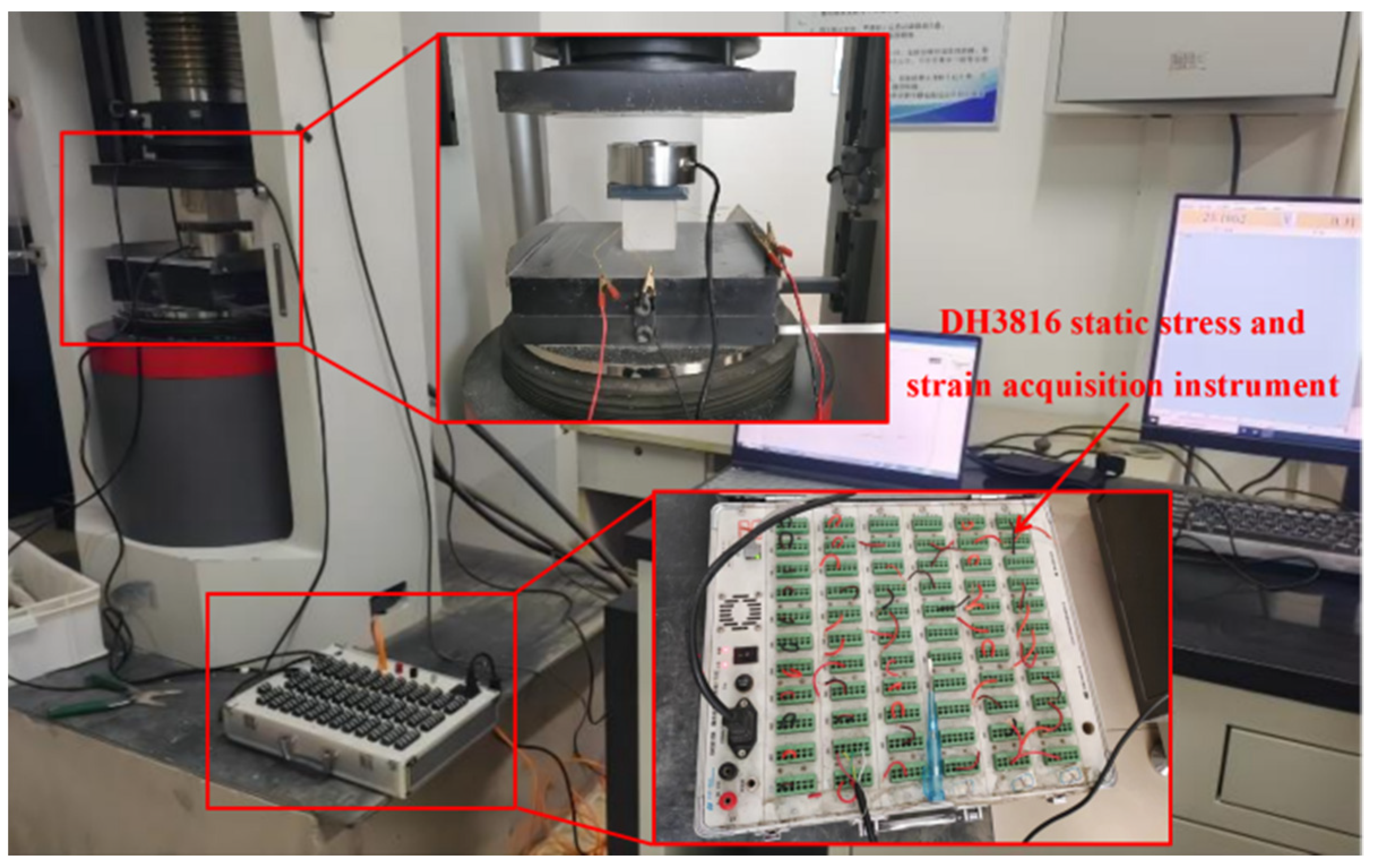
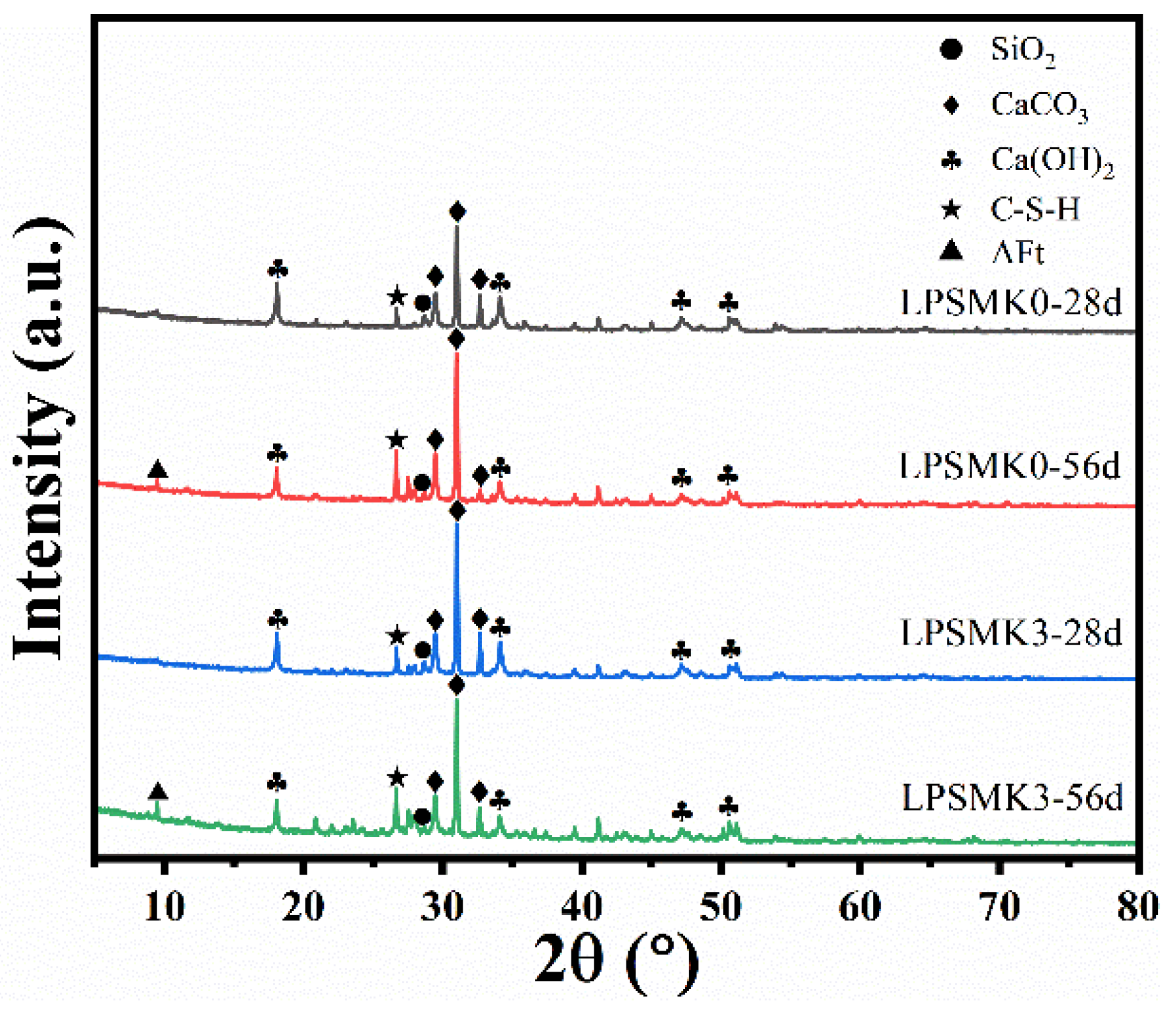

| Whiteness % | Fineness % | Standard Consistency % | Setting Time (min) | Flexural Strength (MPa) | Compressive Strength (MPa) | |||
|---|---|---|---|---|---|---|---|---|
| Initial Setting | Final Setting | 3 d | 28 d | 3 d | 28 d | |||
| 90.5 | 1.8 | 28.51 | 184 | 234 | 5.1 | 7.4 | 26.6 | 41.7 |
| Oxide | CaO | SiO2 | MgO | Al2O3 | K2O | Fe2O3 |
|---|---|---|---|---|---|---|
| Mass Fraction (%) | 67.96 | 17.21 | 9.34 | 1.43 | 0.82 | 0.28 |
| Oxide | SiO2 | Al2O3 | TiO2 | Fe2O3 | CaO | K2O |
|---|---|---|---|---|---|---|
| Mass Fraction (%) | 54.42 | 42.68 | 1.77 | 0.54 | 0.23 | 0.13 |
| Oxide | CaO | MgO | SiO2 | Al2O3 | K2O | Fe2O3 |
|---|---|---|---|---|---|---|
| Mass Fraction (%) | 97.11 | 1.20 | 0.86 | 0.35 | 0.19 | 0.12 |
| Test No. | White Cement (%) | Lime (%) | Heavy Calcium Carbonate (%) | MK (%) | Cement–Sand Ratio | Water–Cement Ratio |
|---|---|---|---|---|---|---|
| LPSMK0 | 35.0 | 40.0 | 25.0 | 0 | 1:2 | 0.60 |
| LPSMK1 | 35.0 | 37.0 | 25.0 | 3.0 | ||
| LPSMK2 | 35.0 | 34.0 | 25.0 | 6.0 | ||
| LPSMK3 | 35.0 | 31.0 | 25.0 | 9.0 | ||
| LPSMK4 | 35.0 | 28.0 | 25.0 | 12.0 |
| Test No. | MK (%) | Elastic Modulus (GPa) | Poisson’s Ratio |
|---|---|---|---|
| LPSMK0 | 0 | 2.19 | 0.253 |
| LPSMK1 | 3.0 | 4.35 | 0.194 |
| LPSMK2 | 6.0 | 4.57 | 0.156 |
| LPSMK3 | 9.0 | 6.09 | 0.123 |
| LPSMK4 | 12.0 | 7.88 | 0.107 |
Disclaimer/Publisher’s Note: The statements, opinions and data contained in all publications are solely those of the individual author(s) and contributor(s) and not of MDPI and/or the editor(s). MDPI and/or the editor(s) disclaim responsibility for any injury to people or property resulting from any ideas, methods, instructions or products referred to in the content. |
© 2024 by the authors. Licensee MDPI, Basel, Switzerland. This article is an open access article distributed under the terms and conditions of the Creative Commons Attribution (CC BY) license (https://creativecommons.org/licenses/by/4.0/).
Share and Cite
Wang, X.; Shang, H.; Zhou, J.; Gu, L.; Xiao, Z.; Wang, X.; Wang, R. Enhancing Hydraulic Lime Mortar with Metakaolin: A Study on Improving Restoration Materials for Historic Buildings. Materials 2024, 17, 3548. https://doi.org/10.3390/ma17143548
Wang X, Shang H, Zhou J, Gu L, Xiao Z, Wang X, Wang R. Enhancing Hydraulic Lime Mortar with Metakaolin: A Study on Improving Restoration Materials for Historic Buildings. Materials. 2024; 17(14):3548. https://doi.org/10.3390/ma17143548
Chicago/Turabian StyleWang, Xiaolong, Huaishuai Shang, Junhao Zhou, Lilong Gu, Zhenhao Xiao, Xiaoqin Wang, and Ruiping Wang. 2024. "Enhancing Hydraulic Lime Mortar with Metakaolin: A Study on Improving Restoration Materials for Historic Buildings" Materials 17, no. 14: 3548. https://doi.org/10.3390/ma17143548





